gas type DODGE RAM 5500 CHASSIS CAB 2008 3.G Owners Manual
[x] Cancel search | Manufacturer: DODGE, Model Year: 2008, Model line: RAM 5500 CHASSIS CAB, Model: DODGE RAM 5500 CHASSIS CAB 2008 3.GPages: 528, PDF Size: 7.84 MB
Page 71 of 528

Children Too Large for Booster Seats
Children who are large enough to wear the shoulder belt
comfortably, and whose legs are long enough to bend
over the front of the seat when their back is against the
seat back should use the lap/shoulder belt in a rear seat.
²Make sure that the child is upright in the seat.
²The lap portion should be low on the hips and as snug
as possible.
²Check belt fit periodically. A child's squirming or
slouching can move the belt out of position.
If the shoulder belt contacts the face or neck, move the
child closer to the center of the vehicle. Never allow a
child to put the shoulder belt under an arm or behind
their back.
NEW ENGINE BREAK-IN
5.7L Gas Engine
A long break-in period is not required for the engine in
your new vehicle. Drive moderately during the first 300
miles (500 km). After the initial 60 miles (100 km), speeds
up to 50 or 55 mph (80 or 90 km/h) are desirable. While
cruising, brief full-throttle acceleration, within the limits
of local traffic laws, contributes to a good break-in.
Avoid wide open throttle acceleration in low gear.
The engine oil installed in the engine at the factory is a
high quality, energy conserving type lubricant. Oil
changes should be consistent with the anticipated cli-
matic conditions under which vehicle operation will
occur. The recommended viscosity and quality grades are
discussed in Section 7 under Maintenance Procedures,
Engine Oil.
THINGS TO KNOW BEFORE STARTING YOUR VEHICLE 71
2
Page 167 of 528

UNDERSTANDING YOUR INSTRUMENT PANEL
CONTENTS
mInstruments And Controls.................171
mInstrument Clusters.....................172
N5.7L Gas Engines......................172
N6.7L Cummins Diesel Engines............173
mInstrument Cluster Description.............174
mElectronic Digital Clock..................183
NClock Setting Procedure.................184
mRadio General Information................184
NRadio Broadcast Signals.................184NTwo Types Of Signals..................184
NElectrical Disturbances..................185
NAM Reception.......................185
NFM Reception........................185
mSales Code REF Ð AM/FM/CD (Single Disc)
Radio With Optional Satellite Radio And Hands
Free Phone Capability...................186
NOperating Instructions - Radio Mode.......186
NOperation Instructions - CD Mode.........190
NOperation Instructions - Auxiliary Mode.....1924
Page 337 of 528
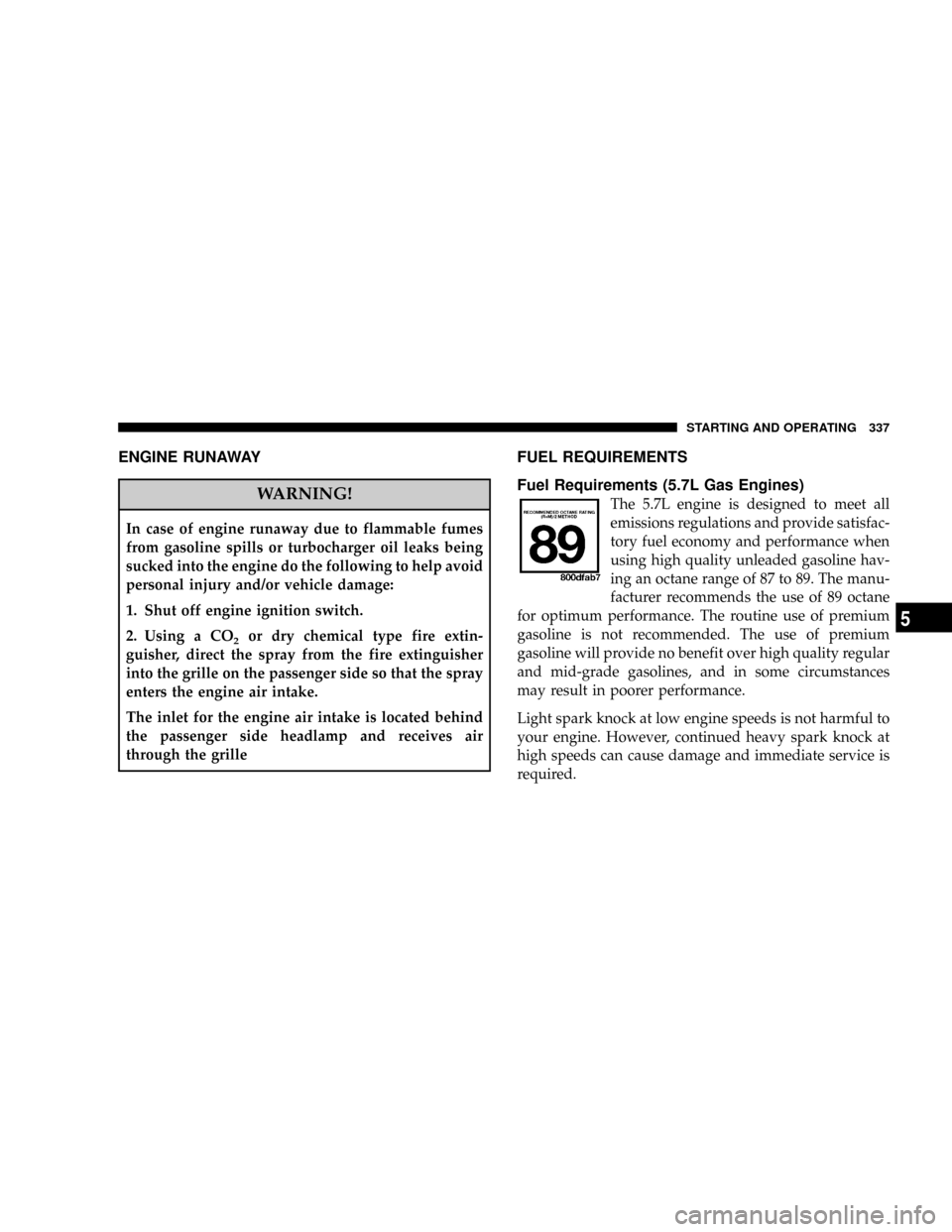
ENGINE RUNAWAY
WARNING!
In case of engine runaway due to flammable fumes
from gasoline spills or turbocharger oil leaks being
sucked into the engine do the following to help avoid
personal injury and/or vehicle damage:
1. Shut off engine ignition switch.
2. Using a CO
2or dry chemical type fire extin-
guisher, direct the spray from the fire extinguisher
into the grille on the passenger side so that the spray
enters the engine air intake.
The inlet for the engine air intake is located behind
the passenger side headlamp and receives air
through the grille
FUEL REQUIREMENTS
Fuel Requirements (5.7L Gas Engines)
The 5.7L engine is designed to meet all
emissions regulations and provide satisfac-
tory fuel economy and performance when
using high quality unleaded gasoline hav-
ing an octane range of 87 to 89. The manu-
facturer recommends the use of 89 octane
for optimum performance. The routine use of premium
gasoline is not recommended. The use of premium
gasoline will provide no benefit over high quality regular
and mid-grade gasolines, and in some circumstances
may result in poorer performance.
Light spark knock at low engine speeds is not harmful to
your engine. However, continued heavy spark knock at
high speeds can cause damage and immediate service is
required.
STARTING AND OPERATING 337
5
Page 408 of 528

Engine Oil Selection (Gas Engines)
For best performance and maximum protection under all
types of operating conditions, the manufacture only
recommends engine oils that are API certified and meet
the requirements of DaimlerChrysler Material Standard
MS-6395. Use Mopar or an equivalent oil meeting the
specification MS-6395.
American Petroleum Institute (API) Engine Oil
Identification Symbol
This symbol means that the oil has
been certified by the American
Petroleum Institute (API). The
manufacture only recommends
API Certified engine oils.
Engine Oil Viscosity (SAE Grade)
For trucks with a 5.7L engine operating under a gross
combined weight rating of 14,000 lbs or greater, SAE
5W-30 engine oil is recommended for all operating
temperatures. For all other trucks with a 5.7L engine,
operating under a gross weight rating less than 14,000
lbs SAE 5W-20 engine oil is recommended for all
operating temperatures. These engine oils improve low
temperature starting and vehicle fuel economy. Your
engine oil filler cap also shows the recommended
engine oil viscosity for your vehicle.
For information on engine oil filler cap location, see the
Engine Compartment illustration in this section.
Lubricants which do not have both, the engine oil certi-
fication mark and the correct SAE viscosity grade num-
ber should not be used.
408 MAINTAINING YOUR VEHICLE
Page 411 of 528
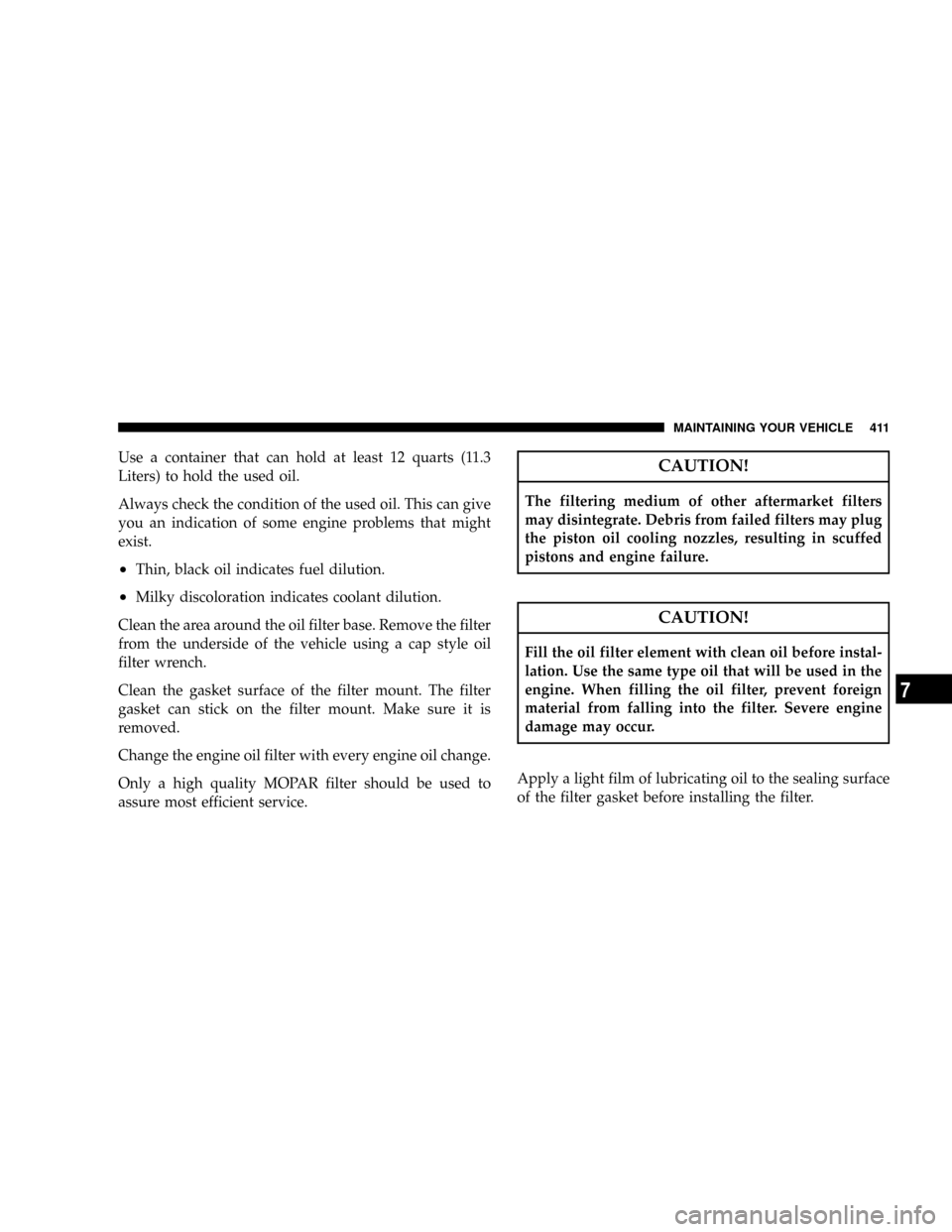
Use a container that can hold at least 12 quarts (11.3
Liters) to hold the used oil.
Always check the condition of the used oil. This can give
you an indication of some engine problems that might
exist.
²Thin, black oil indicates fuel dilution.
²Milky discoloration indicates coolant dilution.
Clean the area around the oil filter base. Remove the filter
from the underside of the vehicle using a cap style oil
filter wrench.
Clean the gasket surface of the filter mount. The filter
gasket can stick on the filter mount. Make sure it is
removed.
Change the engine oil filter with every engine oil change.
Only a high quality MOPAR filter should be used to
assure most efficient service.
CAUTION!
The filtering medium of other aftermarket filters
may disintegrate. Debris from failed filters may plug
the piston oil cooling nozzles, resulting in scuffed
pistons and engine failure.
CAUTION!
Fill the oil filter element with clean oil before instal-
lation. Use the same type oil that will be used in the
engine. When filling the oil filter, prevent foreign
material from falling into the filter. Severe engine
damage may occur.
Apply a light film of lubricating oil to the sealing surface
of the filter gasket before installing the filter.
MAINTAINING YOUR VEHICLE 411
7
Page 420 of 528

mixture in excess of 5% can negatively impact the on-
engine fuel filter's ability to separate water from the fuel,
resulting in high pressure fuel system corrosion or dam-
age.
NOTE:As sufficient testing has not been completed,
ethanol blends are not recommended or approved for use
with your Cummins Diesel equipped vehicle.
NOTE:In addition, commercially available fuel addi-
tives are not necessary for the proper operation of your
Cummins Diesel equipped vehicle.
Engine Fuel Filter (Gas Engines)
A plugged fuel filter can cause stalling, limit the speed at
which a vehicle can be driven or cause hard starting.
Should an excessive amount of dirt accumulate in the
fuel tank, frequent filter replacement may be necessary.
Spark Plugs (Gas Engines)
Spark plugs must fire properly to assure engine perfor-
mance and emission control. New plugs should be in-
stalled at the specified mileage. The entire set should be
replaced if there is any malfunction due to a faulty spark
plug, malfunctioning spark plugs can damage the cata-
lytic converter. For proper type of replacement spark
plugs, refer to the Fluids, Lubricants and Genuine Parts
section in this manual.
Catalytic Converter (Gas Engines)
The catalytic converter requires the use of unleaded fuel
only. Leaded gasoline will destroy the effectiveness of the
catalyst as an emission control device.
Under normal operating conditions, the catalytic con-
verter will not require maintenance. However, it is im-
portant to keep the engine properly tuned to assure
proper catalyst operation and prevent possible catalyst
damage.
420 MAINTAINING YOUR VEHICLE
Page 433 of 528
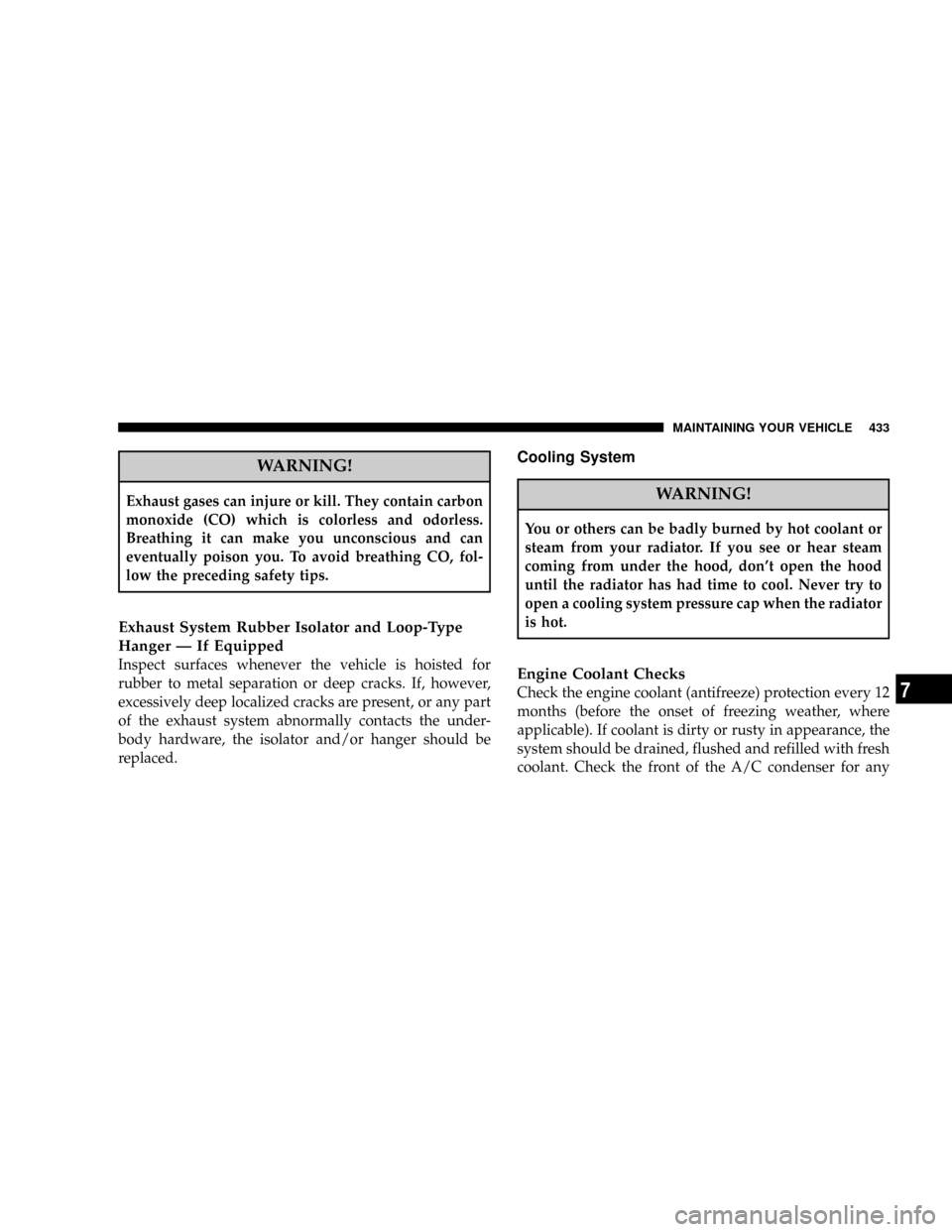
WARNING!
Exhaust gases can injure or kill. They contain carbon
monoxide (CO) which is colorless and odorless.
Breathing it can make you unconscious and can
eventually poison you. To avoid breathing CO, fol-
low the preceding safety tips.
Exhaust System Rubber Isolator and Loop-Type
Hanger Ð If Equipped
Inspect surfaces whenever the vehicle is hoisted for
rubber to metal separation or deep cracks. If, however,
excessively deep localized cracks are present, or any part
of the exhaust system abnormally contacts the under-
body hardware, the isolator and/or hanger should be
replaced.
Cooling System
WARNING!
You or others can be badly burned by hot coolant or
steam from your radiator. If you see or hear steam
coming from under the hood, don't open the hood
until the radiator has had time to cool. Never try to
open a cooling system pressure cap when the radiator
is hot.
Engine Coolant Checks
Check the engine coolant (antifreeze) protection every 12
months (before the onset of freezing weather, where
applicable). If coolant is dirty or rusty in appearance, the
system should be drained, flushed and refilled with fresh
coolant. Check the front of the A/C condenser for any
MAINTAINING YOUR VEHICLE 433
7
Page 439 of 528

²Do not change the thermostat for summer or winter
operation. If replacement is ever necessary, install
ONLY the correct type thermostat. Other designs may
result in unsatisfactory coolant performance, poor gas
mileage, and increased emissions.
Fan
Inspection
Check the fan for cracks and bent or broken blades. If any
of these conditions exist, you must replace the fan. Make
sure it is securely mounted.
NOTE:This service procedure must be performed by a
trained service technician. Make arrangements with your
authorized Dodge Truck Dealer for this inspection.
Charge Air Cooler Ð Inter-Cooler (Diesel
Engines)
The charge air cooler is positioned between the radiator
and the air conditioner condenser. Air enters the engine
through the air cleaner and passes through the turbo-
charger where it is pressurized. This pressurized air
rapidly reaches high temperature. The air is then directed
through a hose to the charge air cooler and through
another hose to the intake manifold of the engine. The air
entering the engine has been cooled by about 50 to 100
degrees Fahrenheit. This cooling process enables more
efficient burning of fuel resulting in fewer emissions.
To guarantee optimum performance of the system, keep
the surfaces of the charge air cooler, condenser and
radiator clean and free of debris. Periodically check the
hoses leading to and from the charge air cooler for cracks
or loose clamps resulting in loss of pressure and reduced
engine performance.
MAINTAINING YOUR VEHICLE 439
7
Page 446 of 528
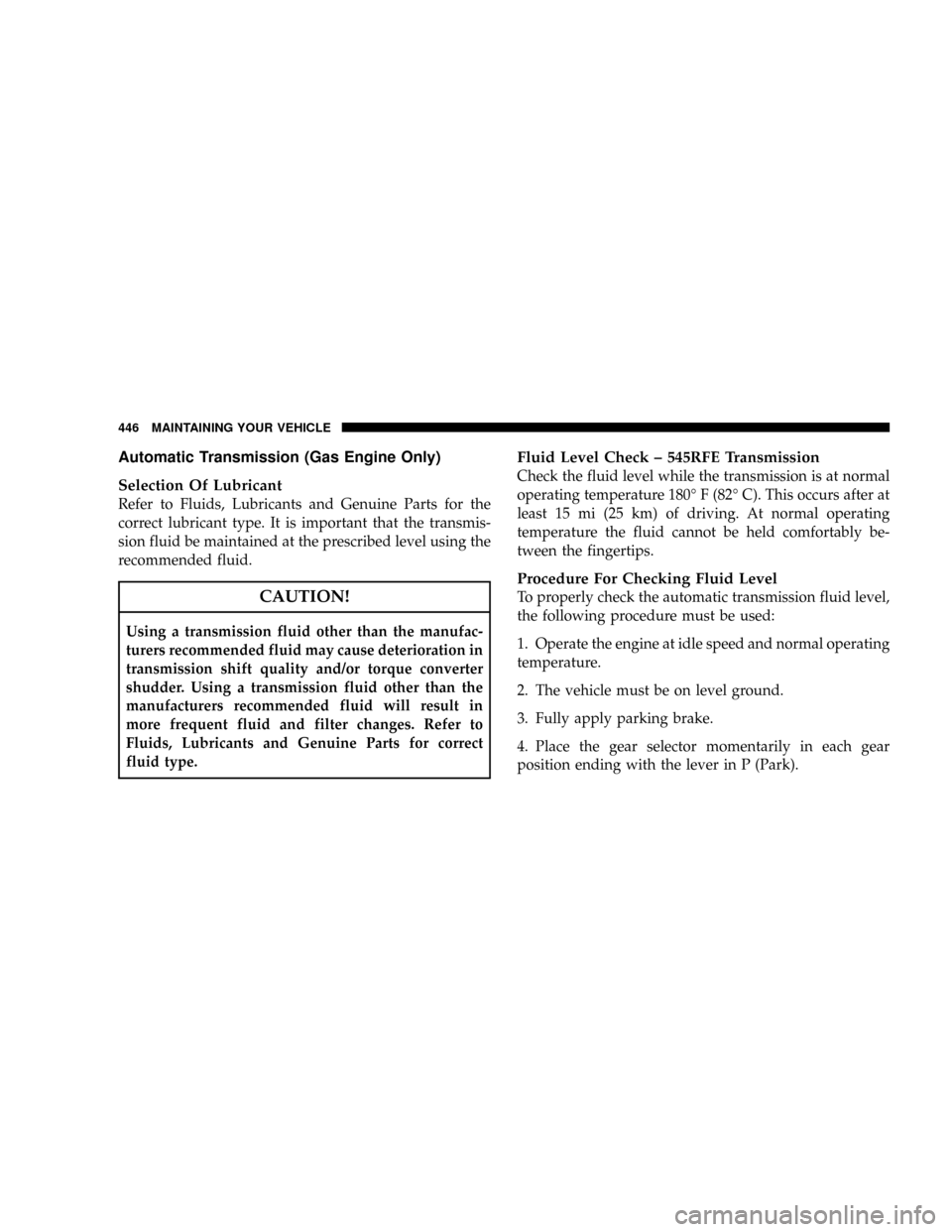
Automatic Transmission (Gas Engine Only)
Selection Of Lubricant
Refer to Fluids, Lubricants and Genuine Parts for the
correct lubricant type. It is important that the transmis-
sion fluid be maintained at the prescribed level using the
recommended fluid.
CAUTION!
Using a transmission fluid other than the manufac-
turers recommended fluid may cause deterioration in
transmission shift quality and/or torque converter
shudder. Using a transmission fluid other than the
manufacturers recommended fluid will result in
more frequent fluid and filter changes. Refer to
Fluids, Lubricants and Genuine Parts for correct
fluid type.
Fluid Level Check ± 545RFE Transmission
Check the fluid level while the transmission is at normal
operating temperature 180É F (82É C). This occurs after at
least 15 mi (25 km) of driving. At normal operating
temperature the fluid cannot be held comfortably be-
tween the fingertips.
Procedure For Checking Fluid Level
To properly check the automatic transmission fluid level,
the following procedure must be used:
1. Operate the engine at idle speed and normal operating
temperature.
2. The vehicle must be on level ground.
3. Fully apply parking brake.
4. Place the gear selector momentarily in each gear
position ending with the lever in P (Park).
446 MAINTAINING YOUR VEHICLE
Page 528 of 528
INTRODUCTION INTRODUCTION A MESSAGE FROM DAIMLERCHRYSLER CORPORATION - DIESEL ENGINES ONLY HOW TO USE THIS MANUAL WARNINGS AND CAUTIONS VAN CONVERSIONS/CAMPERS VEHICLE IDENTIFICATION NUMBER VEHICLE
MODIFICATIONS/ALTERATIONS THINGS TO KNOW BEFORE STARTING YOUR VEHICLE A WORD ABOUT YOUR KEYS Ignition Key RemovalLocking Doors With The KeySENTRY KEY Replacement KeysCustomer Key ProgrammingGeneral InformationSTEERING
WHEEL LOCK - IF EQUIPPED If You Wish To Manually Lock The Steering WheelTo Release The Steering Wheel LockAutomatic Transmission Ignition Interlock SystemSECURITY ALARM SYSTEM - IF EQUIPPED Rearming of the SystemTo Set the AlarmTo Disarm the
SystemILLUMINATED ENTRY SYSTEM - IF EQUIPPED REMOTE KEYLESS ENTRY - IF EQUIPPED To unlock the doorsTo lock the doorsUsing the Panic AlarmGeneral InformationTransmitter Battery Service REMOTE STARTING SYSTEM - IF EQUIPPED DOOR LOCKS
Manual Door Locks - If EquippedPower Door Locks - If EquippedChild Protection Door LockWINDOWS Power Windows - If Equipped Power Sliding Rear Window -If Equipped Sliding Rear Window - If EquippedWind BuffetingOCCUPANT RESTRAINTS Lap/Shoulder Belts
Adjustable Upper Shoulder Belt AnchorageAutomatic Locking Restraint (ALR) Mode - If EquippedCenter Lap BeltsSeat Belt PretensionersEnhanced Driver Seat Belt Reminder System (BeltAlert) Seat Belts and Pregnant WomenSeat Belt ExtenderDriver And Right Front
Passenger Supplemental Restraint System (SRS)-AirbagEvent Data Recorder (EDR)Child RestraintNEW ENGINE BREAK-IN 5.7L Gas Engine6.7L Diesel EngineSAFETY TIPS Transporting PassengersLock Your VehicleExhaust GasSafety Checks You Should Make Inside
The VehicleSafety Checks You Should Make Outside The VehicleUNDERSTANDING THE FEATURES OF YOUR VEHICLE MIRRORS Inside MirrorAutomatic Dimming Mirror - If EquippedOutside MirrorsExterior Mirrors Folding FeatureElectronic Power Mirrors - If Equipped
Electric Rear Window Defroster and Heated Sideview Mirrors - If EquippedTrailer Towing Mirrors - If EquippedHANDS-FREE COMMUNICATION (UConnect) -IF EQUIPPED OperationsPhone Call FeaturesUConnect System FeaturesAdvanced Phone ConnectivityThings
You Should Know About Your UConnect SystemGeneral InformationSEATS 40-20-40 Front Seat Reclining SeatsAdjustable Head RestraintsManual Rotary Lumbar Support Adjustment - If EquippedPower Seats - If EquippedHeated Seats - If EquippedTO OPEN AND CLOSE
THE HOOD LIGHTS Interior Lights Battery SaverHeadlamp DelayHeadlights, Parking Lights, Panel LightsDaytime Running Lights (Canada Only and FleetVehicles)Lights-on ReminderFog Lights - If EquippedMultifunction Control LeverWINDSHIELD WIPERS AND
WASHERS Windshield Wipers Windshield WashersTILT STEERING COLUMN DRIVER ADJUSTABLE PEDALS - IF EQUIPPED AdjustmentELECTRONIC SPEED CONTROL - IF EQUIPPED To ActivateTo Set At A Desired SpeedTo DeactivateTo Resume SpeedTo Vary
The Speed SettingTo Accelerate For PassingOVERHEAD CONSOLE WITH COMPASS/TEMPERATURE MINI-TRIP COMPUTER - IF EQUIPPED US/M Button RESET Button Global ResetStep Button Average Fuel Economy (AVG ECO)Distance To Empty (DTE)Trip
Odometer (ODO)Elapsed Time (ET)C/T Button Automatic Compass CalibrationManual Compass CalibrationRecalibrating The CompassOutside TemperatureOVERHEAD CONSOLE WITH ELECTRONIC VEHICLE INFORMATION CENTER (EVIC) - DIESEL ONLY
Dome/Reading LightsElectronic Vehicle Information Center (EVIC) - If Equipped Compass/Temperature ButtonELECTRICAL POWER OUTLETS CIGAR LIGHTER AND ASH RECEIVER CUPHOLDERS Front Instrument Panel Cupholders (40-20-40 Seats) - Automatic
TransmissionFront Instrument Panel Cupholders (Bucket Seats) - Automatic TransmissionFront Instrument Panel Cupholders - Manual Transmission Rear Cupholder (Quad Cab) - If EquippedSTORAGE Center Storage Compartment (40-20-40 Seat) - If Equipped Center
Storage Compartment (Bucket Seats) - If Equipped Storage and Seats (Quad Cab Models)Plastic Grocery Bag Retainers REAR WINDOW FEATURES Electric Rear Window Defroster and Heated Side view Mirrors - If EquippedPower Sliding Rear Window - If Equipped
Sliding Rear Window - If EquippedFOLD FLAT LOAD FLOOR - IF EQUIPPED UNDERSTANDING YOUR INSTRUMENT PANEL INSTRUMENTS AND CONTROLS INSTRUMENT CLUSTERS 5.7L Gas Engines 6.7L Cummins Diesel Engines INSTRUMENT CLUSTER
DESCRIPTION ELECTRONIC DIGITAL CLOCK Clock Setting ProcedureRADIO GENERAL INFORMATION Radio Broadcast SignalsTwo Types of SignalsElectrical DisturbancesAM ReceptionFM ReceptionSALES CODE REF - AM/FM/CD (SINGLE DISC) RADIO WITH
OPTIONAL SATELLITE RADIO AND HANDS FREE PHONE CAPABILITY Operating Instructions - Radio ModeOperation Instructions - CD ModeOperation Instructions - Auxiliary ModeOperating Instructions - Hands Free Phone - If EquippedOperating Instructions - Satellite
Radio - If EquippedSALES CODE RAQ - AM/FM/CD (6-DISC) RADIO WITH OPTIONAL SATELLITE RADIO, HANDS FREE PHONE, AND VEHICLE ENTERTAINMENT SYSTEMS (VES)CAPABILITIES Operating Instructions - Radio ModeOperation Instructions - (CD MODE
for CD Audio Play)LOAD/EJECT Button (CD Mode for CD Audio Play)Notes On Playing MP3 FilesOperation Instructions - (CD Mode for MP3 Audio Play)LOAD/EJECT Button (CD Mode for MP3 Play)SALES CODE RAK - AM/FM/CASSETTE/CD (6-DISC) RADIO WITH
OPTIONAL SATELLITE RADIO, HANDS FREE PHONE, VIDEO, MP3, and WMA CAPABILITIES Operating Instructions - Radio ModeOperating Instructions - Tape PlayerSeek ButtonFast Forward (FF)Rewind (RW)Tape EjectScan ButtonChanging Tape DirectionMetal Tape
SelectionPinch Roller ReleaseNoise ReductionOperation Instructions - (CD MODE for CD Audio Play)LOAD/EJECT Button (CD Mode for CD Audio Play)Notes On Playing MP3 FilesOperation Instructions - (CD Mode for MP3 and WMA Audio Play)LOAD/EJECT Button
(CD Mode for MP3 and WMA Play)SALES CODE REC - AM/FM/CD (6-DISC) RADIO WITH NAVIGATION SYSTEM Operating Instructions - Satellite Radio (If Equipped)REC Setting the ClockAudio Clock DisplayVIDEO ENTERTAINMENT SYSTEM (SALES CODE XRV)
- IF EQUIPPED SATELLITE RADIO - IF EQUIPPED System ActivationElectronic Serial Number/Sirius Identification Number (ESN/SID)Selecting Satellite Mode in REF, RAQ, and RAK RadiosSelecting a ChannelStoring and Selecting Pre-Set ChannelsUsing the PTY (Program
Type) Button - If EquippedPTY Button SCANPTY Button SEEKSatellite AntennaReception QualityREMOTE SOUND SYSTEM CONTROLS - IF EQUIPPED Radio OperationTape PlayerCD PlayerCASSETTE TAPE AND PLAYER MAINTENANCE COMPACT DISC
MAINTENANCE RADIO OPERATION AND CELLULAR PHONES CLIMATE CONTROLS Heater Only - If Equipped Air Conditioning and Heating - If Equipped Air Conditioning with Dual Zone Temperature Control - If EquippedOperating TipsOperating Tips Chart STARTING
AND OPERATING STARTING PROCEDURES - GAS ENGINES Manual Transmission - If EquippedAutomatic Transmission - If EquippedNormal StartingIf Engine Fails To StartAfter StartingSTARTING PROCEDURES - DIESEL ENGINES Manual Transmission - If Equipped
Automatic Transmission - If EquippedNormal Starting Procedure - Engine Manifold Air Temperature Above 66 degrees F (19 degrees C)Starting Procedure - Engine Manifold Air Temperature Below 66 degrees F (19 degrees C)Starting FluidsNORMAL OPERATION - DIESEL
ENGINE Cold Weather PrecautionsEngine Idling - In Cold WeatherStopping The EngineEngine Speed ControlOperating PrecautionsCooling System Tips -Automatic TransmissionENGINE BLOCK HEATER (GAS ENGINES)- IF EQUIPPED DIESEL EXHAUST BRAKE
(ENGINE BRAKING) - IF EQUIPPED AUTOMATIC TRANSMISSION Automatic Transmission with Overdrive (5 Speed 545RFE) - If EquippedAutomatic Transmission(6 Speed AS68RC) - If EquippedMANUAL TRANSMISSION Manual Transmission - 6 Speed (G56)
Recommended Vehicle Shift SpeedsDownshifting - Gas EngineDownshifting - Diesel EngineFOUR-WHEEL-DRIVE OPERATION - IF EQUIPPED Manually ShiftedTransfer Case Operating Information/PrecautionsShifting Procedure - Manually Shifted Transfer Case Transfer
Case Reminder LightElectronically Shifted Transfer Case Operating Information/Precautions (4 Position Switch) - If Equipped Shifting Procedure- Electronically Shifted Transfer Case LIMITED-SLIP DIFFERENTIAL - IF EQUIPPED POWER TAKE OFF OPERATION - IF
EQUIPPED Stationary ModeMobile ModePower Take Off - Aftermarket InstallationDRIVING ON SLIPPERY SURFACES DRIVING THROUGH WATER Flowing/Rising WaterShallow Standing WaterDRIVING OFF-ROAD PARKING BRAKE BRAKE SYSTEM Brake Noise
Four-Wheel Anti-Lock Brake SystemPOWER STEERING TIRE SAFETY INFORMATION Tire Markings Tire Identification Number (TIN)Tire Loading and Tire PressureTIRES - GENERAL INFORMATION Tire PressureTire Inflation PressuresRadial-Ply TiresLimited Use Spare
- If EquippedTire SpinningTread Wear IndicatorsLife of TireReplacement TiresAlignment And BalanceSUPPLEMENTAL TIRE PRESSURE INFORMATION - IF EQUIPPED TIRE CHAINS SNOW TIRES TIRE ROTATION RECOMMENDATIONS Dual Rear Wheels ENGINE
RUNAWAY FUEL REQUIREMENTS Fuel Requirements (5.7L Gas Engines)Fuel Requirements (6.7L Diesel Engines)ADDING FUEL Adding Fuel (Gas Engines)Adding Fuel (Diesel Engines)VEHICLE LOADING Certification LabelTRAILER TOWING Common Towing
DefinitionsTrailer Hitch ClassificationTrailer Towing Weights (Maximum Trailer Weight Ratings)Trailer and Tongue WeightTowing RequirementsTowing TipsTrailer Towing Mirrors - If EquippedSNOWPLOW Before plowingSnowplow Prep Package Model AvailabilityOver the
Road Operation With Snowplow AttachedMethods For Removing Snow Operating TipsGeneral MaintenanceRECREATIONAL TOWING (BEHIND MOTORHOME, ETC.) Recreational Towing - 2 Wheel Drive ModelsRecreational Towing - 4 Wheel Drive ModelsWHAT TO DO
IN EMERGENCIES HAZARD WARNING FLASHER JACKING AND TIRE CHANGING 3500 Models - If EquippedJACKING INSTRUCTIONS Tire Changing ProcedureHOISTING JUMP-STARTING With Portable Starting UnitFREEING A STUCK VEHICLE EMERGENCY
TOW HOOKS - IF EQUIPPED TOWING A DISABLED VEHICLE 4-Wheel- Drive Vehicles2-Wheel- Drive VehiclesMAINTAINING YOUR VEHICLE ENGINE COMPARTMENT - 6.7LDIESEL ENGINE ENGINE COMPARTMENT- 5.7L GAS ENGINE ONBOARD DIAGNOSTIC
SYSTEM (OBD II) Loose Fuel Filler Cap MessageREPLACEMENT PARTS ENGINE DATA PLATE DEALER SERVICE SERVICE INFORMATION MAINTENANCE PROCEDURES EngineOilDrive Belts (Gas Engines)Drive Belt (Diesel Engines)Engine Air Cleaner Filter (Gas
Engines)Engine Air Cleaner Filter (Diesel Engines)Draining Fuel/Water Separator Filter (Diesel Engines) Engine Fuel Filter (Gas Engines)Spark Plugs (Gas Engines)Catalytic Converter (Gas Engines)Intervention Regeneration Strategy - EVIC Message Process Flow (Catalyst
Full Message) (Diesel Engines Only)Emission-Related Components (Gas Engines)Maintenance Free Battery (Gas Engines)Maintenance Free Batteries(Diesel Engines)Air Conditioner MaintenancePower Steering - Fluid CheckFront Suspension Ball JointsSteering Linkage
- InspectionFront Prop Shaft LubricationFront Axle Universal Drive Joints And Ball JointsBody LubricationWindshield Wiper BladesWindshield WashersExhaust SystemCooling SystemFanCharge Air Cooler - Inter-Cooler (Diesel Engines)Hoses And Vacuum/Vapor Harnesses
Fuel System ConnectionsBrake SystemClutch Hydraulic SystemClutch LinkageRear Axle And 4x4 Front Driving Axle Fluid LevelTransfer Case - If EquippedManual Transmission - If EquippedAutomatic Transmission (Gas Engine Only)Automatic Transmission (Diesel Engine
Only)Front and Rear Wheel BearingsNoise Control System Required Maintenance and WarrantyAppearance Care and Protection from CorrosionFUSES (INTEGRATED POWER MODULE) VEHICLE STORAGE REPLACEMENT LIGHT BULBS BULB REPLACEMENT
Headlight (Halogen)/Front Park and Turn LightsFog LightsCab Top Clearance Lights - If EquippedFLUID AND CAPACITIES FLUIDS, LUBRICANTS AND GENUINEPARTS EngineChassisMAINTENANCE SCHEDULES EMISSION CONTROL SYSTEM MAINTENANCE
MAINTENANCE SCHEDULES - 6.7L TURBO DIESEL Oil Change Indicator SystemMaintenance ScheduleMAINTENANCE SCHEDULE - 5.7L GAS ENGINE Required Maintenance IntervalsIF YOU NEED CONSUMER ASSISTANCE SUGGESTIONS FOR OBTAINING
SERVICE FOR YOUR VEHICLE Prepare For The AppointmentPrepare A ListBe Reasonable With RequestsIF YOU NEED ASSISTANCE WARRANTY INFORMATION (U.S. Vehicles Only) MOPAR PARTS REPORTING SAFETY DEFECTS In CanadaPUBLICATION ORDER
FORMS DEPARTMENT OF TRANSPORTATION UNIFORM TIRE QUALITY GRADES TreadwearTraction GradesTemperature GradesINDEX